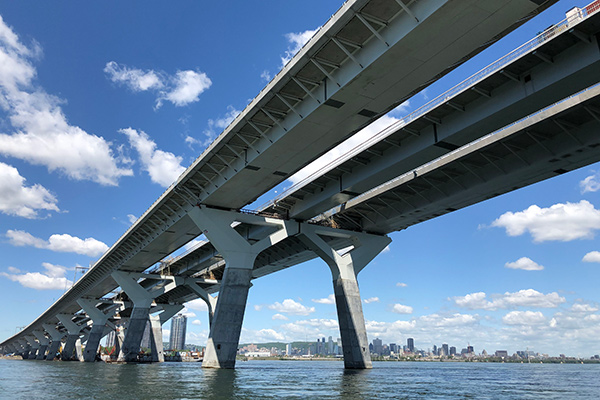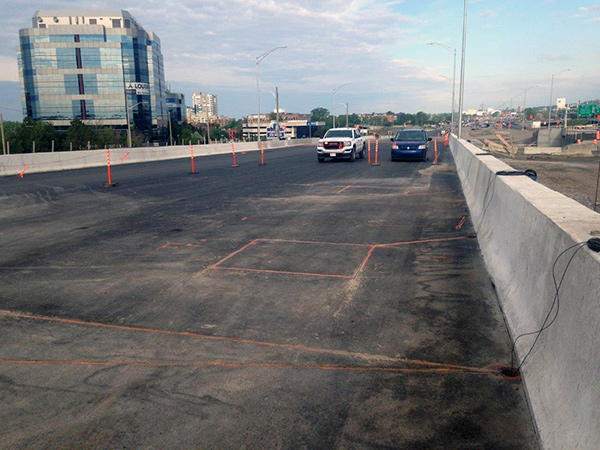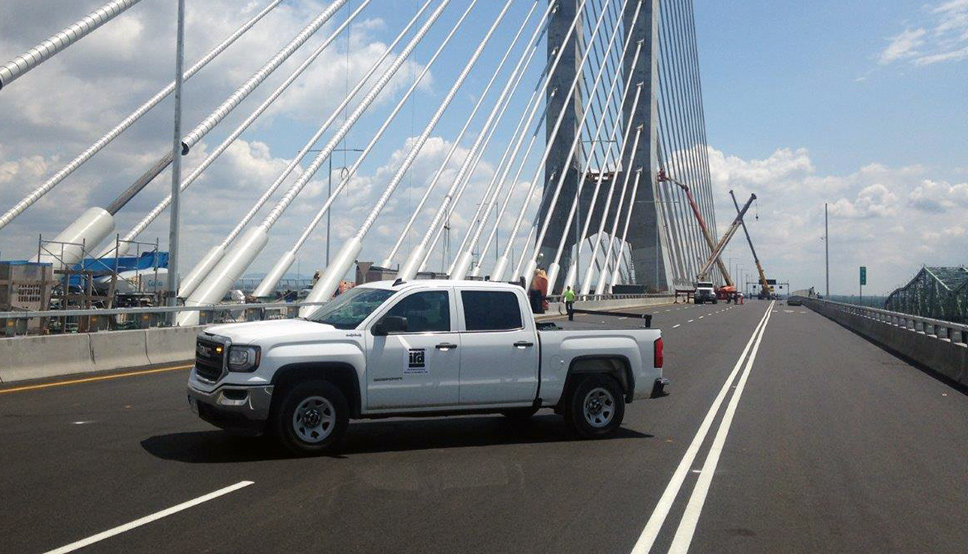The Samuel De Champlain Bridge is one of the busiest spans in North America, with 50 million vehicles crossing it each year. More than $20 billion in Canada-United States trade passes over the crossing annually.
The Government of Canada initiated a project to replace the old Champlain Bridge in 2015, and the new bridge opened to traffic on July 1, 2019. Built as a public-private partnership (P3), the project has created thousands of jobs and will have a positive impact on the local, regional and national economies.

The New Champlain Bridge
Objectives of the Samuel de Champlain bridge project were to:
- Construct a new 3.4-kilometre replacement for the old Champlain Bridge
- Handle increased traffic on the route
- Protect the surrounding environment through rigorous environmental monitoring and mitigation measures
- Enhance Montreal’s cityscape and contribute to the corridor’s status as the main gateway to the city
- Provide a transit corridor for public transit
- Enable safe, accessible transportation for pedestrians and cyclists through construction of a multi-use path
IRD’s role in the New Champlain Bridge Corridor Project was the installation of Piezoelectric Weigh-In-Motion (WIM) sensors, iSINC® WIM controllers, and provision of traffic data for 10 lanes of traffic. The traffic data is sent to the Traffic Management Centre (TMC) of the P3 Consortium (Signature on the Saint-Lawrence Group). The data will provide valuable information to help manage the maintenance and operation of the bridge over the 30-year period that the consortium manages the bridge.
Bridge Data Uses
Typically, a baseline is created from the traffic data and is analyzed with respect to current and future trends. Traffic data supports cost effective management for the bridge while meeting safety, environmental, and capacity objectives. For instance, lane traffic volumes may be used to help schedule bridge maintenance at the least disruptive times.
Vehicle classification and weight enable monitoring and forecast of usage by vehicle type. Volume and class data help to estimate the effectiveness of the project in mitigating congestion and can be used by planners to forecast emissions and the impact on air quality. Weight data provides input for future bridge and pavement design, loading restrictions, safety improvements, and determining the need for weight enforcement. The number, weight, and configuration of commercial vehicles are major factors in bridge design, as well as contributing to the calculation of expected remaining bridge life.
Weigh-In-Motion (WIM) Electronics & Sensors
The core of the system is IRD’s iSINC WIM controller, consisting of modular electronics designed specifically for roadside use with hardened electronics and a weatherproof cabinet. The iSINC is capable of real-time traffic monitoring. The WCU (WIM Control Unit) module is the heart of the iSINC—configuring, monitoring, and controling all connected equipment, and aggregating sensor module reports to build sophisticated data collection systems. The WCU module can monitor up to 16 lanes simultaneously, and transfers and stores real-time vehicle data while logging operating conditions and system health.

Samuel De Champlain Bridge – iSINC® Electronics
Various reporting options are available for the data collected by the iSINC including IRD’s iAnalyze® desktop reporting software and VI2M™ cloud-based software. For the Champlain Bridge Corridor project, the data was needed in a format accessible to the consortium’s TMC. To accomplish this, a specialized iSINC module was installed to make the data available in an XML format.
The sensors selected for this project are RoadTrax BL Piezo Traffic Sensors. The unique construction of these sensors allows direct installation into the road in a flexible format so that it can conform to the profile of the road. The flat construction of the sensor gives an inherent rejection of road noise due to road bending, adjacent lanes, and bow waves of approaching vehicles. The small cut in the road minimizes the damage done to the road, speeds up the installation and reduces the amount of grout used for the installation.

Samuel De Champlain Bridge Sensor installation (on approach to bridge)
RoadTrax BL Piezo sensors are used in this application because they are the most cost-effective option for counting, vehicle classification and weighing. Class I Piezo sensors provide research quality data, while Class II Piezo sensors are used for detecting “off-scale” vehicles that move out of the main lanes into the shoulders.
Other options for monitoring bridges include:
- Virtual Weigh Station – real-time enforcement for overloaded trucks
- iCOMS Doppler Radar Sensors – pedestrian and cyclist data



